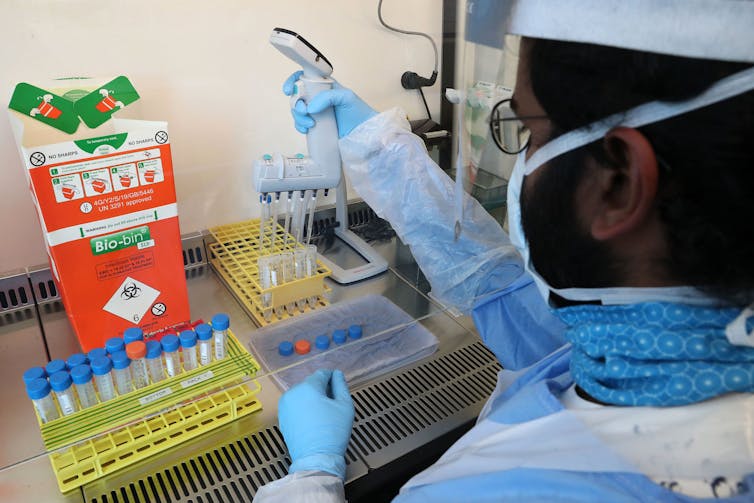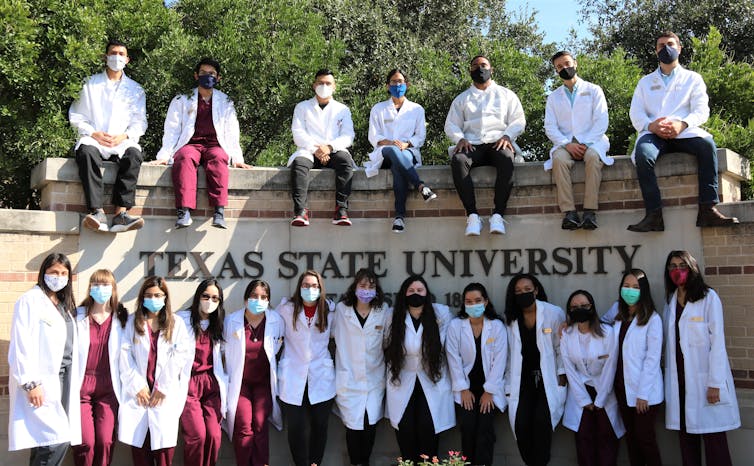Who is doing all those COVID-19 tests? Why you should care about medical laboratory professionals
Rodney E. Rohde, Professor of Clinical Laboratory Science | December 14, 2020

Who do you think performs your medical laboratory tests for COVID-19 or any other test? If you answered “my doctor” or “my nurse” or a robot, you would be completely wrong.
To put it bluntly, your life is in the hands of medical laboratory professionals. We perform an estimated 13 billion laboratory tests in the United States each year. That means that laboratory testing is the single highest-volume medical activity in the lives of Americans.
Why should you care? Those 13 billion tests help drive approximately two-thirds of all medical decisions made by your doctor and other health care professionals from cradle to grave. There are only 337,800 practicing medical laboratory professionals for a population of just over 330 million people in the U.S.
I’ve worked in public health and medical laboratories for three decades, specializing in the study of viruses and other microbes while also educating the next generation of medical laboratory scientists. In 2014, I coined the phrase “the hidden profession that saves lives.” With COVID-19, these unsung professionals are now in the limelight. Unfortunately, this pandemic has led to a nationwide burnout of these professionals, causing dangerous shortages in the U.S. health care infrastructure.
The weight of COVID-19 testing
Medical laboratory testing is performed by highly skilled, rigorously educated, certified, licensed and dedicated medical laboratory professionals. You have probably never seen one of these medical scientists at work because they are rarely in public view – unlike nurses, doctors and pharmacists.
In fact, without the test results we provide, your doctor or other health care professionals are flying blind. Don’t get us wrong – we have great respect and value for all health care professionals. We just want you to understand that we save lives every day even though you don’t necessarily see us in the shadows of health care.
Since the beginning of the COVID-19 pandemic in the U.S., we have performed approximately 213 million tests and counting. And now we are tired. We hear the calls for more testing. Many of my former students, now colleagues in medical laboratories all over the country, are exhausted and dealing with burnout or thoughts of quitting.
The most common form of testing for COVID-19 – and the gold standard – is called a PCR test, which stands for polymerase chain reaction. Like most testing, PCR testing is largely invisible to patients once a nasal swab is taken. The purpose of this test is to detect the virus’s genetic material – called RNA – in the cells collected on the swab.
For laboratory professionals the first step is to convert any RNA from the virus into DNA. Then, using a series of chemical reactions and specialized equipment, the DNA is replicated millions of times so that it is easier to detect. If genetic material from SARS-CoV-2 is detected, then the patient is infected with the coronavirus.
The demands of such a precise test and meticulous process are putting a massive burden on this workforce.
Recently the American Society for Clinical Pathology conducted a survey of laboratory professionals and reported that 85.3% felt burnt out; 36.5% reported inadequate staffing; 31.5% complained of a heavy workload and pressure to complete all testing; and 14.9% cite a lack of recognition and respect.
Part of the weariness stems from the fact that in addition to COVID-19, we are also running tests for people who are having babies, heart attacks, cancer, antibiotic resistant infections, strep throat and other illness or diseases. These 13 billion tests are performed by a workforce that has vacancy rates of 7%-11% in almost every region of the country.
How to become a laboratory science professional
A medical, or clinical, laboratory science degree often requires an average of five years of college education. Medical laboratory scientists all have bachelor’s degrees and have certification or a license to practice. I, and many of my colleagues, have a master’s degree, and also a doctorate. These complex qualifications are reflected in our education and clinical background.
A degree in medical laboratory testing requires mastery of several areas of medicine including the study of hematology, molecular diagnostics, immunology, urine analysis, microbiology, chemistry, parasitology, toxicology, immunohematology (blood banking), coagulation and transfusion, and laboratory safety and operation. I often tell my students that this degree is basically like having to complete four majors.
Our profession can also start toward a laboratory science career at an entry level with a bit less education and clinical training – even as a technician, which requires only a 2-year associate’s medical laboratory technician degree. These technicians often move up the career ladder by obtaining other degrees. Like any health care professional degree, ours is externally accredited through the National Accreditation Agency for Clinical Laboratory Sciences.

Why are there shortages?
Currently there are an estimated 337,800 employed medical laboratory professionals in the U.S., according to the Bureau of Labor Statistics. This is an estimate, because without licenses in every state, an accurate number of practicing laboratory professionals is not available. But the demand for these professionals is expected to grow by 25,000 between 2019 and 2029, according to the Bureau of Labor Statistics. But that doesn’t include the number of jobs that will become vacant when workers retire or leave the profession during the pandemic.
What is frightening to me is that while the demand for clinical laboratory personnel is growing, the number of training programs actually is declining. Currently, there are 235 medical laboratory scientist and 240 medical laboratory technician training programs in the U.S. This is a 7% decline from the year 2000. In some states, there are no programs.
Fewer training programs, coupled with greater demand for laboratory professionals, could impact patient care, notes Jim Flanigan, executive vice president of the American Society for Clinical Laboratory Science. He is concerned by the lack of federal programs supporting medical laboratory education as compared to all other health programs. Vacancy rates are exceeding the number of medical laboratory scientist and medical laboratory technician graduates.
A number of other factors help explain our low workforce numbers. Training laboratory personnel is expensive, and there are few scholarship or loan programs available for prospective students. Salaries are also problematic. Compared to nursing, physical therapists or pharmacists, our professionals are paid 40%-60% less on average for annual salaries.
How to fix the problem
The American Society for Clinical Laboratory Science is calling for expansion of the Title VII health professions program – which provides education and training opportunities in high-demand disciplines – to include medical (clinical) laboratory science. The organization also supports efforts to improve visibility of the profession by engaging in community outreach opportunities and by partnering with middle and high school STEM programs to show young people that laboratory medicine is a viable career path.
Lastly, with competition for laboratory personnel intensifying over the last year, turnover rates for some categories of laboratory personnel now exceed 20%. Because of the difficulty in finding qualified staff, medical laboratories are increasingly turning to temporary staff to handle the patient testing workload. In a sense, the pandemic has exacerbated a “free-agent” effect for traveling medical laboratory professionals that hurts continuity and quality in health care.
We hope that you see us and hear us. Your life or that of a loved one depends on it.![]()
This article is republished from The Conversation under a Creative Commons license. Read the original article.
About The Conversation
The Conversation (https://theconversation.com/us) is an independent, nonprofit publisher of commentary and analysis, authored by academics and edited by journalists for the general public. The Conversation publishes short articles (800-1000 words) by academics on timely topics related to their research.
Share this article
For more information, contact University Communications:Jayme Blaschke, 512-245-2555 Sandy Pantlik, 512-245-2922 |